| Wednesday, April 25 – Priene, Didyma and Miletus
We had a nice breakfast on Hotel Bella’s rooftop terrace while we watched the storks. We met a couple our age from San Luis Obispo. Their itinerary is almost identical to ours (except they are two days ahead of us). They’re even staying in some of the same hotels – must have read the same travel guides. They had just bought an $800 carpet from Erdal (the Hotel Bella has a carpet shop next to the lobby).
Grand Wonders tour bus picked us up at 9:30. (We had booked the tour while we were still in Istanbul.) Although we expected to be going to Ephesus today, this tour was off to the countryside to the three ancient cities -- Priene, Didyma and Miletus (the tour we expected to do tomorrow). The bus meandered through Selcuk gathering 12 other tourists. Our guide was terrific. She was serious, very knowledgeable and loved the ancient cities. I liked the way she walked fast and took charge of the group.
The drive to our first stop, the ancient city of Priene, was pleasant, with views of the Aegean Sea and countryside that reminded me of Tuscany. We saw miles of cotton and tobacco fields and tangerine groves.
The ancient Greek city of Priene, dating back to 300 B.C., was perched on a pine-forested hill beneath the towering Mount Mikale, overlooking the Meander River floodplain. Priene, connected with 12 other important ancient cities, was originally a port city, but then the silt built up and now it is several miles inland.
We climbed a hill to the city and stopped at a map where our guide began her series of talks. She told us that the architect Hippodamus (4th Century B.C.), the first city planner, designed Priene and came up with some of these basic concepts for this masterpiece of urban planning.
- Main Street ran through the center of town
- Streets ran at right angles
- Special areas were designated for special activities -- financial, marketplace (fish vendors even separated from other vendors), religious, housing, etc.
- City was blocked out in a grid system of squares -- The squares were divided into smaller squares for housing and left in larger squares for community activities.
- Aqueducts carried the water to the city through a system of pipes -- If you were wealthy, bigger sections of pipe carried more water to your house.
- Big stone steps and thick walls kept armies out
Priene remained a Greek city because the Romans passed it by – We saw nothing but Greek buildings and temples. At the other sites, the conquering Romans built over the Greek cities and now we have Roman ruins obscuring Greek ruins (obscuring whatever came before starting way back in 1100 B.C.).
Priene was a great city and a favorite of Alexander the Great. He and his family stayed in Priene for 6 years, before dying of malaria. (There was a real problem with malaria because as the river dried up, the swamps were a great breeding ground for mosquitos.)
We strolled along the marble highways and saw the remains of the amphitheater, gymnasium, marketplace, temples, council chambers, statues and other rubble that couldn’t be readily identified. Our guide pointed out the pipes that were once part of the city’s water system.
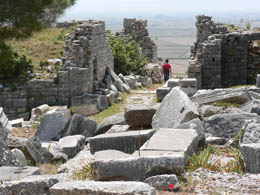
Strolling through ancient Priene
|
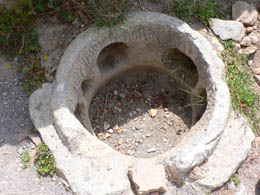
Ancient water pipe |
I loved the nicely preserved, 5,000-seat Greek amphitheater with its special front-row seats for dignitaries and an alter to sacrifice an animal before the opening act. The amphitheater was used for both performances and meetings of elected officials. We learned that the Greeks used the semi-circle shape for their theaters while the Roman’s used the horseshoe shape.
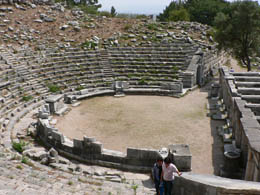
Greek amphitheater |
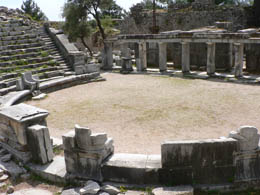
Facing the Stage |
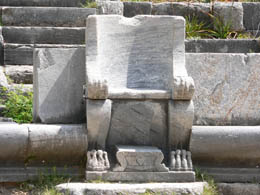
Special Seating |
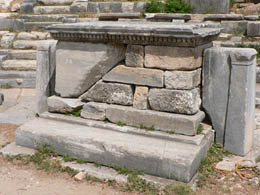
The Sacrificial Alter |
The Temple of Athena, located on a hill, was partially restored. One of the best-preserved structures is the Assembly Building (or Senate house) which seated 640 people. It was here that the votes were counted after the elections.
Another nearby building housed the eternal flame. Eunuchs were in charge of maintaining the eternal flame because they were not as easily distracted as those “full-membered” citizens who were occupied by earthly thoughts. The eternal flame burned continuously until the Christians came and put it out.
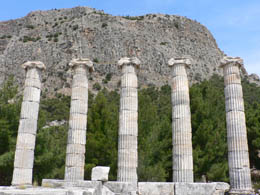
Temple of Athena with a backdrop of pine trees and mountains
|
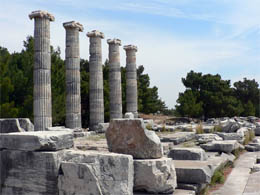
Temple of Athena |
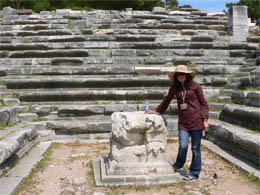
Our Guide in the Assembly Building
|
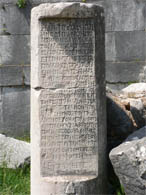
Tablet Displaying City Rules |
Our next stop was lunch for some pitiful fish, but fresh strawberries for dessert. Our restaurant overlooked the grand Temple of Apollo in the sacred city of Didyma. After lunch we explored Didyma, watched over by Medusa.
People once traveled miles on the sacred marble highway (King’s Highway) to Didyma to consult the oracle of Apollo. They first would wash themselves in the well outside the temple and then wait on the steps. After paying a fee (could even be a fish), they were led inside the temple chambers to sleep. Apollo would come to them in a dream with the answer. Alexander the Great once came here to consult the oracle and learned that he would defeat the Greeks (and he did). The seat of the Oracle here at Didyma was just as famous as the Oracle of Delphi in Greece.
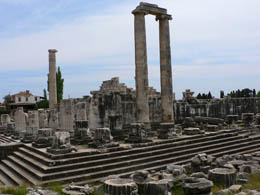
Temple of Apollo
|
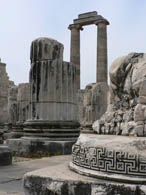
Temple of Apollo |
The first sanctuary of the temple was built in 800 B.C., and then in 560 B.C. the enormous temple was constructed. Some 70 years later, when the Persians attacked the city (490 B.C.), the bronze statue of Apollo was taken. They later had to return it around 300 B.C. after Alexander the Great defeated the Persians. (And that’s how it is with the spoils of war.)
The magnificent columns were made of heavy discs lifted into place by a pulley system. Once the column was erected, slaves, hanging on ropes from the top of the columns, chiseled the deep vertical grooves. What a job that must have been!
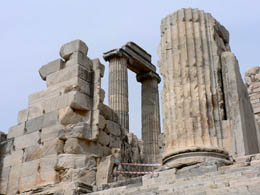
Columns of the Temple of Apollo
|
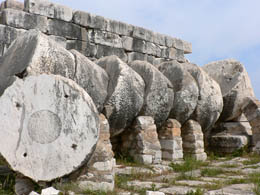
Collapsed Column – circular sections still in tact |
The two remaining 60-foot columns have been standing here intact for 2400 years! They were never reconstructed – A miracle, given the frequent earthquakes and wars that have destroyed so much of the ancient sites in this part of the world. Also impressive were the well-preserved marble carvings, especially the Medusa heads.
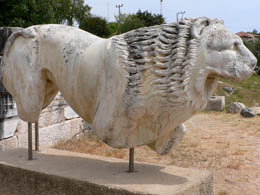
Lion to greet you |
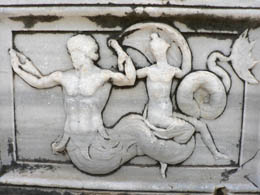
Sea creatures carved in the base of a column |
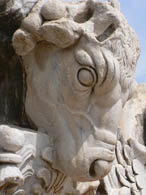
Sacred Cow
|
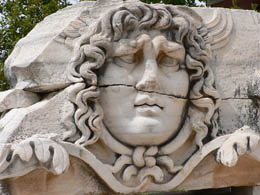
Medusa head |
Connected to Didyma by the sacred marble highway was Miletus, the cradle of philosophy and science in the 6th Century B.C. Miletus was a sprawling city, even larger than Ephesus. Now miles from the Aegean Sea, it was once a wealthy port city located on a natural harbor with a population around 100,000. Most of the city is now buried, destroyed by an earthquake in 1975.
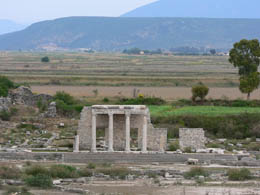
View of what once was the harbor at Miletus |
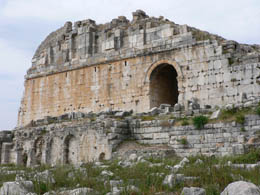
Ruins of Miletus |
Miletus claims a number of “firsts”:
- First school of philosophy,
- First city planner was born here (Hippodamus who designed Priene),
- First heating system (for the baths),
- First alphabet,
- First astronomer, Thales, to calculate precisely the arrival of the solar eclipse,
- First women’s protest (after being captured by the Romans, women refused to speak to them).
The best-preserved structure in Miletus is the theater, built during the Hellenistic period. During the construction, some of the workers got upset over pay, and etched graffiti into some of the seats showing the construction manager with a noose around his neck. The Romans later expanded the theater seating capacity to 24,000 people and made it suitable for both Greek drama and man-beast competition. Lions were released from cages beneath the stands to do battle with armed gladiators. There is a huge bas-relief depicting a gladiator and lion. This was the first theatre to issue tickets, which were made out of aluminum.
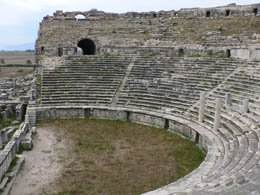
Greek semi-circle shaped theater |
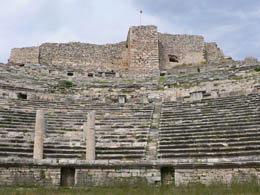
Seating for 24,000 people |
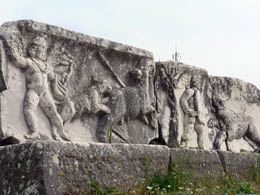
Bas-relief - A gladiator and lion |
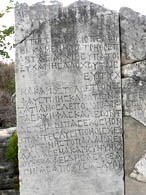
Stone tablets – first alphabet invented here |
Around 200 A.D, Marcus Aurelius built the Baths of Faustina for his wife. The first heating system was used here. The baths had an elaborate system of cold and hot pools, as well as a sauna, gym and locker room. The Romans loved their baths and they loved to eat. They would hang out at the baths all day, eating, vomiting and then eating some more.
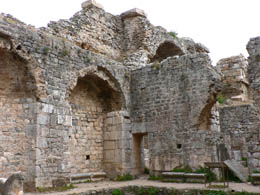
Roman Baths |
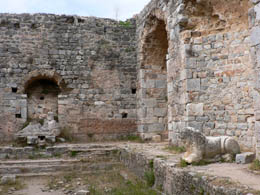
Once a pool at the baths |
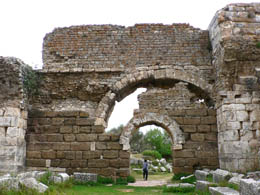
Leaving the baths |
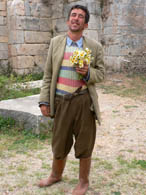
Simple, harmless Turk passing out flowers |
Our guide told us that most of the sites were excavated by Germans. They are excellent archeologists – researching, labeling and piecing the ancient cities back together. However, they took a lot of finds back to Germany. (We heard lots of stories of different countries laying claim to Turkey’s ancient treasures and then the ensuing court battles to get the items returned.)
Returning to the Hotel Bella (and our larger, upgraded room), we again had dinner on the terrace, next to the fireplace. We had a nice chat with some Australians who had just come from Gallipoli, where they had commemorated ANZAC day, and had not slept for 48 hours.
I used the hotel’s very slow computer to compose a long email to Amy, only to have it vanish into cyberspace when I hit “send.” I headed back to our room to help with the laundry and read.
Thursday, April 26 – Ephesus
At 9:30 we jumped on a bus for our tour of Ephesus. After collecting more passengers we discovered we were on the wrong bus (in fact, the wrong company) and headed to Pierne, Didyma, and Miletus, where we had been yesterday. They hurried us through town to connect with the Ephesus bus just as it was leaving. We were disappointed not to have the same guide we had yesterday. Gury, the new guide, seemed bored. I cut him some slack because he was recovering from the flu.
The sites at Ephesus are fantastic and to think only 20% of the ancient city has been excavated. It must have taken massive resources and a huge slave force to build such a place. It was originally a Greek city built about 1000 BC where the Meander River met the Aegean Sea. During the Roman era, Ephesus was the main seaport on the Aegean and center of commerce for thousands of years. I imagined what it was like to be a Roman soldier returning to Ephesus with all its grandeur and Roman might. The harbor has since silted up and now Ephesus is three miles from the sea.
A Brief History of Ephesus
Around the 10th century B.C. Androklos, son of the King of Athens and his friends were sent to Anatolia (ancient Turkey) to establish a new Greek city. They could not decide where to locate the new city so they consulted the oracle of Apollo. The oracle told Androklos, “Where a fish has jumped and a boar takes flight, you will found a town with a magnificent future.” Androklos and his friends wandered around looking for something that had to do with a fish and a boar. They stopped to cook some fish for lunch. The freshly caught, not-quite-dead, fish kept jumping out of the pan, scattering flames that set nearby dry bushes on fire. A boar ran out of the burning bushes. Androklos chased the boar, caught it and killed it. Convinced that the prophesy of the oracle had come true, Androklos established the new city of Ephesus in this location.
400 years later, Ephesus, as prophesied, became a very prosperous city. Later (as history goes), the Lydians and then the Persians came in and conquered it. In 334 BC, Alexander the Great and his armies marched into Ephesus and captured it from the Persians without any resistance.
Ephesus came under the sovereignty of Rome, and Emperor Augustus declared Ephesus the capital of the Roman provinces. It prospered and grew to a population of 200,000. |
Entering the gate from the east, you pretty much follow a linear path down through the ancient city that is crawling with tourists. Most of them just came off massive cruise ships in port. Our guide knew how to maneuver our little group through the masses avoiding group after group moving behind numbered flags.
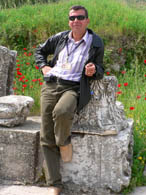
Gury, Our Guide |
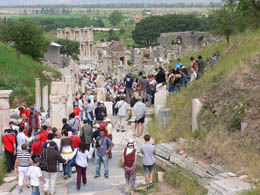
Crowds at Ephesus |
We started with the baths and made our way down large promenades, past the market place (agora), private houses, temples, the brothel, the library, theatre, and stadium where gladiators once fought.
Ephesus was big on baths. The Baths of Varius are on the east entrance and the Port Baths are on the west (or port) entrance. During the Roman rule, everyone who traveled to Ephesus had to take a bath upon entering the city to get rid of bugs and cut down on disease.
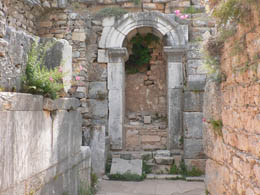
Baths of Varius |
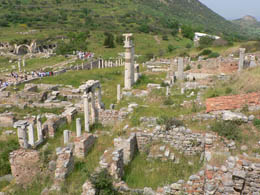
Overview of Ephesus from the East |
The huge business complex was on the eastern side of the city. The business agora (market) was the financial district and administrative center of the city. Here loans were made, taxes were collected, and business deals were sealed. On the western side of the city, next to the port, was the shopping agora – a massive mall where vendors sold goods, food, trinkets and anything one might want from their stalls. A hot seller was the mini replicas of the ancient gods. They made great souvenirs on the way to the theatre or stadium. St. Paul caused a stir with these vendors when he preached in Ephesus against worshipping pagan gods. When their sales plummeted, he was no longer welcome in the city.
Next to the baths on the eastern entrance was the Odeon, a small theater that held up to 2,000 people, built in the 11 th Cent. A.D, by a nobleman (Vedius Antonis) and his wife (Flavia Papiana). The place was used for concerts and theatre performances as well as the meeting place for the Roman Council.
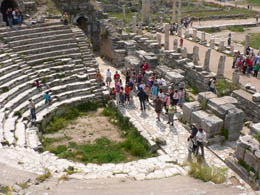
Odeon |
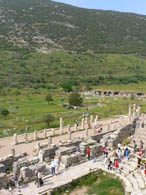
View from the top seats in the Odeon |
I imagined what it was like to stroll down ancient Ephesus on the streets lined with fountains and statues, stopping at the magnificent temples.
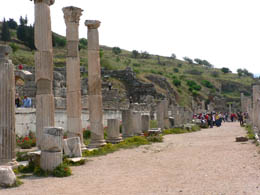
Wide Promenades |
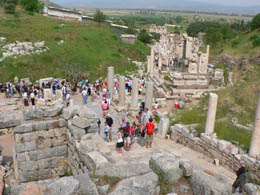
Strolling through town |
The Temple of Hadrian is one of the main attractions at Ephesus. Its arch, atop two columns, has a bust of the goddess Tych, who protected Ephesus. There is also a stone plaque with the names of four Roman emperors.
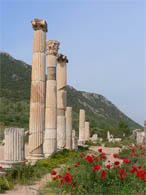
The Monument of Memnius |
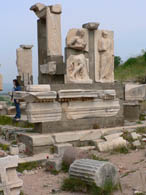
The Monument of Memnius |
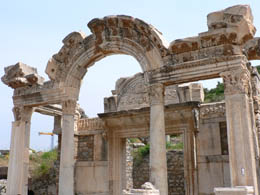
Temple of Hadrian |
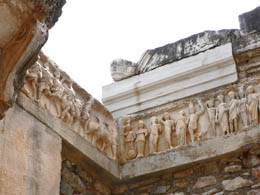
Sculpted Friezes, Temple of Hadrian |
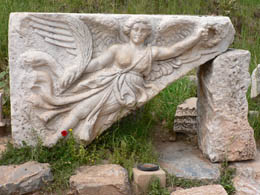
Nike, Goddess of Victory |
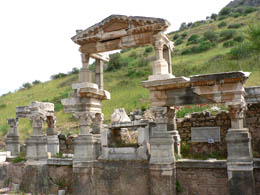
The Fountain of Trajan |
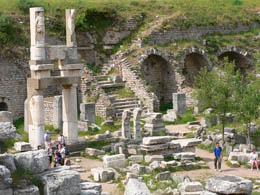
The Temple of Domitian (built between 87 and 96 AC) |
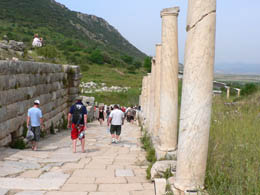
Priests’ Way (marble walkway) |
We decided to leave our group and take the optional tour of the terrace houses on the hill. The houses were the palatial private residences occupied between the 3rd century BC and 7th century A.D. The houses are covered by a huge warehouse structure and excavation is still going on. We had only about 20 minutes to see the houses and rejoin our group. We followed a maze, going from one large open room to another. We saw mosaic tile floors and brightly colored frescoes. We observed archeologists sorting through piles of fragments, trying to put the pieces of the puzzle back together. They were most interesting, but in our rush to connect with our group in the main part of Ephesus, we missed the latrines and House of Love. Oh well, try as we may, we can’t do everything.
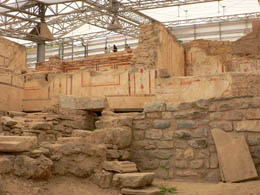
Terrance Houses |
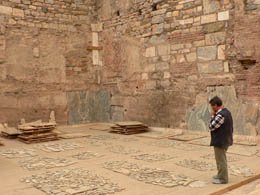
Piecing the puzzle together |
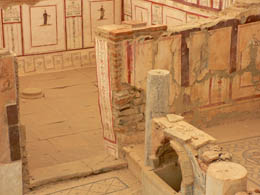
Terrance Houses |
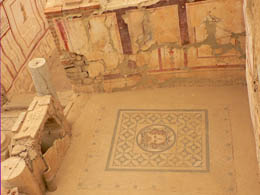
Terrance Houses |
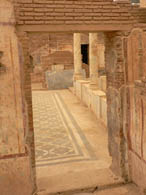
Terrance Houses |
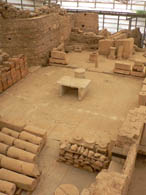
Terrance Houses |
The Library of Celsus (11th Cent. A.D.) knocked my socks off. In front were two tiers of tall marble columns holding statues of gods and goddesses of knowledge, thought and wisdom. We followed the Marble Way to the library’s paved courtyard where the learned men lectured and discussed political, philosophical and other issues of the day. We entered the wide steps into the large reading room where precious paper scrolls were once kept. What a place this must have been!
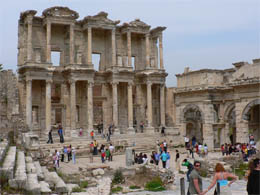
Library of Celsus |
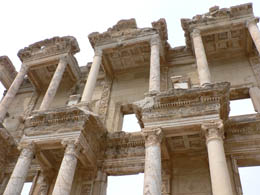
Library Façade - 2 tiers of tall marble columns |
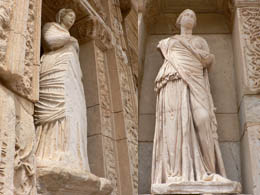
Gods and Goddesses of knowledge, thought and wisdom |
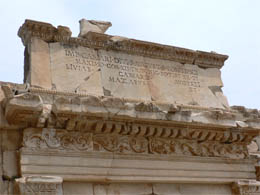
Library of Celsus |
The Large Theater (11th cent. A.D.) was one of the largest theaters in the Aegean area, holding 25,000 people. The theatre was used for gladiator contests, animal fights, lectures (political and philosophical discussions), concerts, plays, and religious purposes. The festival to honor Artemis, Goddess of Fertility, was held here and St. Paul preached here.
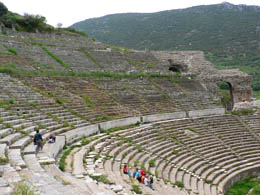
Large Theater |
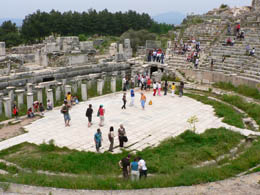
Large Theater – stage area |
Just down the road was the massive stadium. All over the ruins in Ephesus and other ruins in Turkey, we saw crude divided circle symbols carved into the marble. When the Christians finally conquered these grand cities, they destroyed the statues and buildings and then etched these circle symbols into the marble. It looked like ancient graffiti.
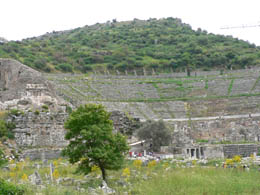
Theater |
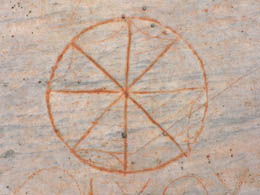
Christian markings |
After climbing around the Large Theater, we made our way down to the Arcadian Way that led out to sea. The large road was named in honor of Emperor Arcadius who restored it in 400 A.D. and paved it with marble. Shops lined the road on each side and at night, it was lit with lamps. On this road Cleopatra made her triumphal entrance to Ephesus.
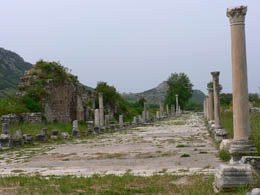
The Arcadian Way |
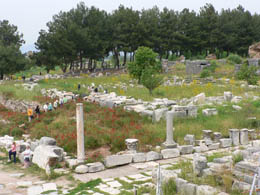
What’s left of shops along the Arcadian Way |
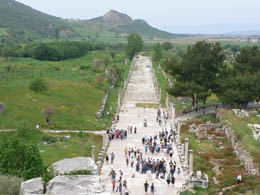
Arcadian Way leading to the Sea |

City populated with red poppies |
After Ephesus our tour guide took us to an awful restaurant (cafeteria food, long lines at restrooms, and rows of tables) – Yuck!
Next stop was the wonderful Ephesus Museum in Selcuk. It was loaded with artifacts from Ephesus and helped us fill in many blanks from Ephesus. The highlights for us were the marble statues of Cybele/Artemis, whose rows of egg-like breasts symbolize fertility.
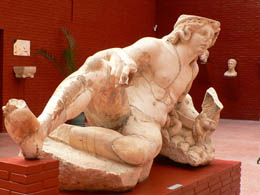
Ephesus Museum in Selcuk |
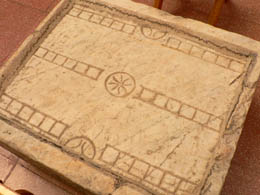
Ancient board game (precursor to Backgammon) |
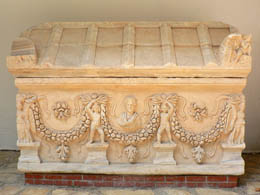
Sarcophagus (tombs everywhere!) |
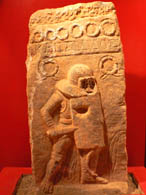
Gladiator carved in stone |
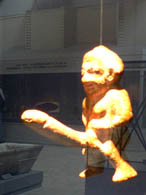
Priapos or God Bes, the phallic symbol of Ephesus |
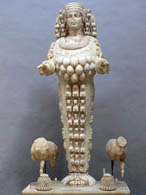
Artemis – Goddess of Fertility |
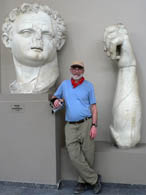
Bill – God of Video |
After the museum, we drove to the Temple of Artemis, built over a swamp to keep earthquakes from destroying it. It is one of the seven wonders of the ancient world, but you wouldn’t know it by looking at the one remaining column (of the original 133). The temple was destroyed several times, once by a fire. We wondered how a marble structure could catch on fire. We learned that the foundation had been filled in with bushes and lumber. An oil lamp fell into the foundation and poof, up in flames.
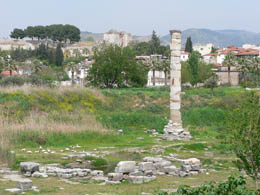 Temple of Artemis today |
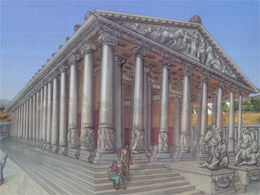
Artist's version of what original temple looked like |
The rest of the tour group visited pottery and jewelry shops to see demonstrations and then get pressured to buy. Not for us – we said good-bye to the pals we had made and walked back to town. We visited St. John’s Basilica, where St. John is buried. After the death of Christ, St. John came with Mary to Ephesus, spreading the word of Christianity. It was here St. John wrote his gospel. In the 4th century, a small church was built around his grave. Later, in the 5th century, a huge domed basilica was constructed to honor him. It was marble and shaped like a cross. St. John’s Basilica was one of the most sacred places in the Middle Ages. Invading Mongols destroyed the basilica in 1402. From the basilica we gazed up at the castle on the hill (built to protect the basilica, but not open to the public).
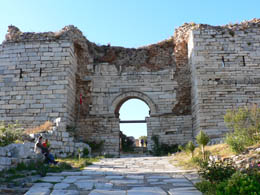
Entrance to St. John’s Basilica |
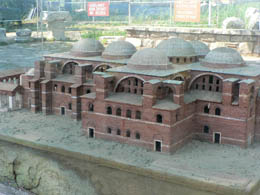
Model of St. John’s Basilica |
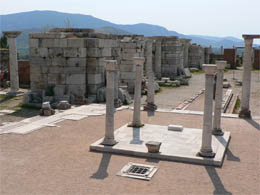
St. John’s tomb |
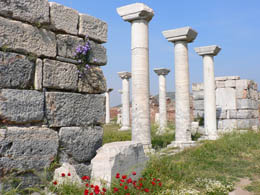
St. John’s Basilica |
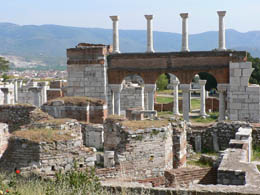
St. John’s Basilica |
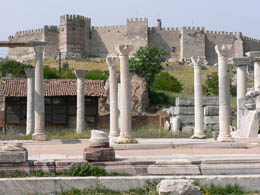
Castle built on hill to protect the basilica |
We returned to the hotel to look for any stork activity, check email, drink a beer, and catch up on the journal.
Bill found a restaurant in the Frommer’s guide—the Garden Camping Restaurant—where the food was to die for. It was a strange experience. To get there we walked down a country road past the Isa Bey Mosque and through a gate that looked like it belonged in a concentration camp. But 100 yards later we found ourselves in an incredible oasis with gorgeous grounds -- pool, gardens, bar, and patio. No one but a few employees were there. The hostess greeted us. I adored her – she was fun loving and spunky. We bonded immediately. After she seated us, the fabulous food began. The hostess took us to the kitchen to watch the chef make our dinner—everything fresh from their garden — salad, chicken and vegetables in a clay pot, and meat in special sauces. After dinner we looked around the new motel rooms and the carpet shop (no pressure to buy). We also saw the large orange grove. The owner (who is Italian) plans to add a zoo next year. Wonderful evening!
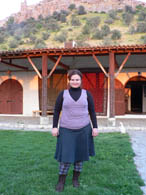
Our Darling Hostesses - Garden Camping Restaurant |
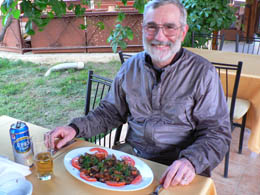
One satisfied customer! |
Back at the Hotel Bella, we chatted with some friendly Aussies and had a good Bush-bashing discussion with a gay couple. Bill tried to pay our bill. The hotel insisted that our room was already paid for. What’s going on here?
|











